COMMENTS ON THE ART MARKET
Gallery News
Where Was I? Hammond At Zanesville
 We are excited to announce that Hammond’s Where Was I? (which is currently available for sale at our gallery) was accepted into the online Ohio Annual exhibition hosted by the Zanesville Museum of Art, Zanesville, OH. In its 76th year, this competitive, juried exhibition welcomed submissions from all Ohio artists in all stages of their careers. Seventy-eight artists were chosen from more than four hundred who submitted works, each vying for the opportunity to exhibit their work at the museum.
We are excited to announce that Hammond’s Where Was I? (which is currently available for sale at our gallery) was accepted into the online Ohio Annual exhibition hosted by the Zanesville Museum of Art, Zanesville, OH. In its 76th year, this competitive, juried exhibition welcomed submissions from all Ohio artists in all stages of their careers. Seventy-eight artists were chosen from more than four hundred who submitted works, each vying for the opportunity to exhibit their work at the museum.
Where Was I? is a bridge, transporting the artist from a set of emotional works that came before, to his more bold/colorful pieces. According to Hammond: There are times when a mood you wish to express or an event that you wish to capture the essence of just can not be expressed in color. Its almost as if the beauty and joy of something so colorful would be a disservice to something so serious.
Long known for my bright, bold, contrasting and often outrageous use of color, in 2018 I began painting Five Forward and Five Backward. These two sister paintings were about the passing of my mother. Gone were the bright, bold colors in exchange for black, white and shades of gray to reflect the hardship I was forced to face. They were serious paintings about a life changing event that I as the artist, felt no joy in creating. In retrospect I think the experience of working on those two canvases took a larger toll on me than I thought they would.
When I finished the two works a year later, I prepared to move on. For some reason though, I felt I couldn’t just dive back into colorful work and I needed a painting that could point me in the right direction to where I was before. I needed something to bridge back to where I normally create.
Enter: Where Was I?
Where was I? had been painted with the intention of being that bridge. Coming back from work that was so serious, color could not be a distraction, to a world filled with color grabbing your attention at every corner. This was a painting that would take from both worlds in order to mount a smooth transition to where I just was to where I wanted abstract to be.
If you build a bridge, make sure it leads to somewhere!
Immediately following Where Was I?, Blue Pair was painted. The ability to grab your attention with bold and exciting color, while still telling a story, has now returned.
The exhibition opened on June 23rd and will run through September 9, 2022. You can view all the exhibited works here: 76th Ohio Annual Exhibition-ONLINE .
____________________
Stocks & Crypto
By: Lance
Welp, this marks the halfway point of 2022… if you’ve been following the market, you probably already know things have been pretty rough, but you may not have realized this has been the worst 6-month stretch to start a year in more than half a century!
Look, before we get into it, in my honest assessment, the levels we were seeing were unreasonable… I mean, over the past two years we saw record-setting gains through one of the most difficult times in recent history. If you think about it in that context, and the fact that we are still up from the onset of the pandemic, perhaps things aren’t as bad as they could be. Nevertheless, it is jarring to see the numbers… The Dow Jones has shed more than 15% year-to-date, the S&P is down more than 20%, and the tech-heavy Nasdaq is down nearly 30%!
Much of it can be explained with the ongoing Russian invasion of Ukraine disrupting oil markets, the Fed pushing interest rates, and soaring inflation… but knowing the cause doesn’t make it any easier to stomach the volatility. And it isn’t going to get better anytime soon… by all estimations, this bear market will bleed into a full-blown recession that will likely drag on through 2023, with growth becoming stagnant.
Looking at currencies and commodities, we saw the Pound and Euro drop considerably with respect to the US Dollar. The Pound was around $1.35 at the start of the year, now just above $1.20; and the Euro was around $1.14, steadily declining to the $1.04 range. Gold has settled back down to where it started the year after seeing a run up that coincided with the onset of war in Ukraine. But the big gainer of 2022 is crude… climbing from the mid-70s to more than $100. Obviously, that is good for oil companies, but not the average American – we’ve seen gas prices skyrocket in recent months, which has only piled onto the hardship.
Now if you thought all of that sounds bad, let us not forget all of the money that has been piled into crypto the past couple of years… but the crypto gods giveth and taketh away. Bitcoin has fallen nearly 60% this year, now sitting below $20K for the first time since 2020. Ethereum is now flirting with $1,000 after pushing the $5K mark late last year, and about one-third the price from where it started the year… the story is nearly identical with Litecoin, which now sits at just $50 after crossing $300 last November. Good thing the gallery didn’t start accepting payments in crypto yet.
I don’t think anyone knows with certainty what is going to happen as we press forward, but with the fed plans to continue rate hikes, soaring inflation, and no signs of Russia slowing its invasion, all signs are pointing in the wrong direction.
Astonishingly, the art and collectibles markets are chugging along just fine… I guess some things are recession proof. As you’ll soon read, auctions are still taking place around the globe with some impressive results! Two Monet’s each topped $36M, two auctions dedicated to works by Marc Chagall beat their overall estimates, a Batman painting by Frank Miller and Lynn Varley garnered $2.3M, and a Star Wars toy rocketed to nearly a quarter of a million dollars!
____________________
The Dark Side
By: Nathan & Howard
The Peaky Blinders Heist
On Tuesday, June 28th, the European Fine Art Fair (TEFAF) in the Dutch city of Maastricht was thrown into chaos when a gang of four men in suit jackets and flat caps smashed a display case and made off with a bag of jewelry. Authorities were completely baffled about how the group could smuggle a gun and a sledgehammer past security, especially since the targeted display was rather far from the show’s entrance. Some witnesses managed to record the incident, which shows one of the robbers breaking into a glass case belonging to the London jewelers Symbolic & Chase. Meanwhile, another held back witnesses at gunpoint. Dutch police have since apprehended two suspects, while the other two remain at large.
Following the robbery, social media was abuzz with photos of the scene and descriptions from witnesses. But mainly, the most common response was ridicule towards the robbers. Because of their matching jackets and flat caps, many have been referring to the gang as the “Peaky Blinders” robbers. This is in reference to the BBC crime drama Peaky Blinders, where many of the male characters sport similar flat caps. Some commentators have highlighted the robbers’ wardrobe as a sign of amateurism, especially since some effort seemed to have gone into their appearance, while none was made to cover the suspects’ faces. While the two suspects now being held by Dutch police are Belgian nationals, art crime investigator Arthur Brand stated that the daylight robbery bears the hallmarks of some Eastern European criminal groups. “There are gangs in Eastern Europe that have specialized in this method. Although it is also an option that the robbers are also stupid.”
Scandal in Slovenia: An Entire Collection Filled with Fakes
 A lot of people have been quitting their jobs lately. Throughout the pandemic, people have resigned for various reasons, from stagnating wages, to a rising cost of living, to general dissatisfaction with their work. But quitting because you failed to do the most basic tasks required of you is certainly an embarrassing low point for anyone. Well, that’s what happened recently to the director of Slovenia’s National Museum.
A lot of people have been quitting their jobs lately. Throughout the pandemic, people have resigned for various reasons, from stagnating wages, to a rising cost of living, to general dissatisfaction with their work. But quitting because you failed to do the most basic tasks required of you is certainly an embarrassing low point for anyone. Well, that’s what happened recently to the director of Slovenia’s National Museum.
Pavel Car, the now-former museum director, oversaw the staging of an exhibition made up of one hundred sixty works from the family of Josip Boljkovac, Croatia’s former interior minister who passed away in 2014. The Travels exhibition was set to feature a large collection of nineteenth- and twentieth-century works by Picasso, Chagall, Toulouse-Lautrec, Turner, and others. After Slovenia’s community of art historians raised many concerns and objections, many of the works were revealed as forgeries. So it was no great surprise when Director Car cancelled the exhibition hours before its opening last Thursday, June 9th. I am sure the Boljkovac family was not very happy since the collection would be worth well over a billion dollars if they were all genuine.
While a revelation of this kind is often rather shocking, the story’s details show that this is less of a tragedy and more of a farce. It seems that the museum administration failed to exercise due diligence when looking into the Boljkovac family collection. The only documentation reviewed was each work’s authenticity certificates, and no attention was paid to provenance, nor was any literature consulted. They did not even take the time to look up the works in the artists’ respective catalogue raisonnés.
But I don’t think looking at the artists’ catalogues was necessary in some of these cases. The exhibition catalogue has since been leaked online. If you look through it, some works were so poorly executed that it seems almost comical that the Boljkovac family collection was even taken seriously. For example, if you turn to page 80 of the catalogue, it shows what was meant to be a still life of bananas and oranges on a table. It’s flat, amateurish, and rough around the edges, reminiscent of some primitivist works (and that’s being generous). So you can imagine the laugh we all had when the caption stated the pastel-on-cardboard work was by the French Post-Impressionist master Paul Cézanne. If you take the time to look at the childish fake, you can then compare it to this authentic Cézanne still life. Though the Cézanne fakes were atrociously executed, they did not stand out by any means. Most of the pieces passed off as being made by Corot, Degas, Vlaminck, Utrillo, and Renoir are such obvious fakes when you look at them long enough.
Why would the Boljkovac family expose themselves like this? Not sure. The most likely explanation is that since they aren’t known as a prominent art-collecting family, this exhibition would increase their exposure and legitimize them within the art world. And it’s also likely that they had no idea a good portion of their collection was made up of fakes. So I guess they didn’t expect this exposure to end in disaster. Slovenian police have since opened an investigation into the incident.
Another Museum Accident
These past two weeks, museums all over the world seem to be at risk of having their collections damaged. Of course, there was the man who threw cake at the Mona Lisa, followed by a break-in at the Dallas Museum of Art, where an intruder damaged several ancient Greek ceramic pieces. And now, this newest incident came out of Madrid. The Spanish capital has three major museums, all located along a ¾-mile stretch of the Paseo del Prado in the city center. While the Prado Museum houses a magnificent collection of Spanish Old Masters like Francisco de Goya and Diego Velázquez, the Reina Sofía Museum is known for its more modern works by Picasso, Dalí, and Miró. Meanwhile, the Thyssen-Bornemisza Museum holds everything in between, and is often overlooked in favor of its bigger siblings. However, this week’s latest accident took place at the Reina Sofía.
 The museum opened in 1992 and was named in honor of Sofía, who was Queen of Spain and is the mother of the current king, Felipe VI. Fun fact, she’s also the first cousin once removed to the late Prince Philip, Duke of Edinburgh. The Madrid museum that bears her name is most famous for housing Pablo Picasso’s monumental work Guernica. While the Picasso works are undamaged, an Italian tourist did have a bit of an accident near a set of stage decorations on display. The scenery was created by the painter Alberto Sánchez for the 1933 premiere of Gustavo Pittaluga’s ballet La romería de los cornudos (The Pilgrimage of the Cuckolds). While trying to take a selfie with the set in the background, the tourist stepped up onto the platform upon which the work was situated. Though very large, the set decoration was made only of watercolor on paper set on a frame. So when she held onto part of the set, it ripped very easily. Thankfully, the museum later stated that the damage was minor and that the work could be back on display as early as Friday. Though the museum informed the police of the incident, this seems like an honest accident (unlike the Dallas incident).
The museum opened in 1992 and was named in honor of Sofía, who was Queen of Spain and is the mother of the current king, Felipe VI. Fun fact, she’s also the first cousin once removed to the late Prince Philip, Duke of Edinburgh. The Madrid museum that bears her name is most famous for housing Pablo Picasso’s monumental work Guernica. While the Picasso works are undamaged, an Italian tourist did have a bit of an accident near a set of stage decorations on display. The scenery was created by the painter Alberto Sánchez for the 1933 premiere of Gustavo Pittaluga’s ballet La romería de los cornudos (The Pilgrimage of the Cuckolds). While trying to take a selfie with the set in the background, the tourist stepped up onto the platform upon which the work was situated. Though very large, the set decoration was made only of watercolor on paper set on a frame. So when she held onto part of the set, it ripped very easily. Thankfully, the museum later stated that the damage was minor and that the work could be back on display as early as Friday. Though the museum informed the police of the incident, this seems like an honest accident (unlike the Dallas incident).
Alexander Grant - SCAMMER
On Monday, May 30th, we received the following email:
Hi, I am an avid art collector and I saw your Inventory through the Askart website and would love to know if the under-listed art pieces are still available for sale, Get back to me with the estimated cost in USD plus shipping and do you accept wire transfer?
PITTSBURGH POINT BRIDGE FROM WATER STREET C.1880 (2000)
John Stobart
AT DAWNS CROSSING
G (Gerald Harvey Jones) Harvey
I’ll appreciate your prompt response in this regard.
Sincerely,
Alexander Grant
I was a bit skeptical about the validity of this email, but I figured let’s see what happens. So I sent the following reply on Tuesday the 31st:
Thank you for your email.
The Stobart is $58,000
G. Harvey is $115,000
Shipping costs will all depend on the location … if you want to give me your mailing address, we can let you know what that is.
A few hours later, “Alexander” replied:
I’ll be happy to have these paintings with me next week in time for my lovely daughter’s birthday so kindly arrange an Invoice addressed to Pacific Mechanical LLC and also get back to me with Wire Instructions which has to Include your Account number, Routing number & Bank address.
My address is below for Calculation of Shipping cost.
2517 Maxine Cir
Sparks, NV 89431-4157
Sincerely,
Alexander Grant.
Later that day, I contacted my bank about the safety and security of our account. The only way you can secure an account is by putting certain safety features in place. Rather than creating an issue with our current account, I decided to open a new one and activated all the features – basically, money can come in, but taking money out needed to pass certain protocols that only we can do. With that now in place, I sent a fake invoice:
Alexander
Attached is an invoice for the two paintings. We will cover the packing; the only additional charge is the freight (which is noted on the invoice). Please let me know when funds are transferred so we can confirm receipt.
Howard
The following day, I decided to give him a little push:
Alex
I want to confirm that you received the invoice for the paintings by Stobart and Harvey? Again, please let us know when the funds will be transferred and the best delivery date?
Howard
On Monday, June 6th, I still had not heard from “Alexander,” and knowing he wanted these works for his daughter’s birthday (ha ha), I sent the following:
Alexander
I assumed you would be sending the funds last week since you needed the works this week. I guess you are not moving forward with the purchase?
Howard
Well, it did not take long to receive the following:
Hello Howard,
It is only a temporary delay and our accountant is working on it. Sorry for any Inconveniences.
Sincerely,
Alexander Grant.
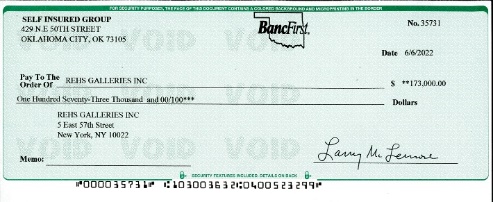 I assumed this would continue for a few more days, but I was wrong. The next morning, we received a small envelope via FedEx from HA Friend & Co, Zion, IL. I opened it and discovered a check (image below) in the amount of $173,000 (a little short of the full amount $173,800 which included the shipping). I thought to myself, weren’t the funds going to be transferred in? Just one more red flag. I took the flimsy check in my hand and noticed the name of the company on the check was different from all the other names and addresses – Self Insured Group, Oklahoma City – and the bank was BancFirst.
I assumed this would continue for a few more days, but I was wrong. The next morning, we received a small envelope via FedEx from HA Friend & Co, Zion, IL. I opened it and discovered a check (image below) in the amount of $173,000 (a little short of the full amount $173,800 which included the shipping). I thought to myself, weren’t the funds going to be transferred in? Just one more red flag. I took the flimsy check in my hand and noticed the name of the company on the check was different from all the other names and addresses – Self Insured Group, Oklahoma City – and the bank was BancFirst.
I decided to call the bank to confirm that the check was fraudulent. Their people were only able to tell me that the company and account number were correct, but the signature on the check did not match anyone in the company. I then called Self Insured Group. After a few attempts, I finally reached a lovely woman who informed me that their account had been hacked and several bogus checks were issued — ours being one of them. She then asked if I would tell her the amount, which I did — that gave her a really good laugh!
I then sent “Alexander” the following:
I received the check today and canceled the sale.
It is not the first time someone tried to scam us with a bogus check, and it will not be the last. I recommend that everyone be a little cautious — remember the old adage – better safe than sorry. On a side note, if anyone would like to own a great work by either G. Harvey or John Stobart, just let us know… they are still available!
Destruction in Dallas
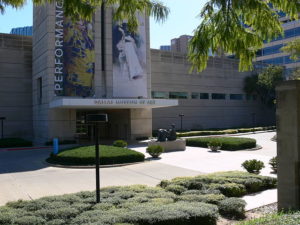
Security at the Dallas Museum of Art (DMA) called the police last Wednesday night, June 1st, in response to a man who had broken into the facility. Once the 21-year-old man had been arrested and taken away, security surveyed some of the damage the intruder had done. Wielding a steel chair, the man smashed several display cases, nearly destroying four artifacts in the process. Three of the four pieces damaged were 2500-year-old Greek artifacts: a ceramic wine cup with mythological decorations, a cylindrical container with its original lid, and an ancient amphora. The final piece destroyed was a ceramic work by Chase Kahwinhut Earles, a contemporary indigenous artist. Some other items were also damaged, but only to a minor extent.
While some sources cite the total damage at the Dallas Museum of Art at a little over $1 million, other sources claim the museum suffered closer to $5.1 million in damage. Of course, this is just an initial estimate. It’s likely inflated to prepare for dealing with the actual cost of the damage. Why did this happen? Well, according to the suspect, he got mad at his girlfriend and needed to vent. Some people scream into a pillow, while others write an angry email and delete it. Well, not in Dallas. Let’s smash up a museum. Consequently, the suspect is being charged with criminal mischief. Thankfully, the museum was ready to open the next day. Meanwhile, the museum is conducting an internal audit to determine how specialists can restore the damaged artifacts.
____________________
Really?
By: Amy
Russian Journalist Helps Ukraine With His Prized Possession
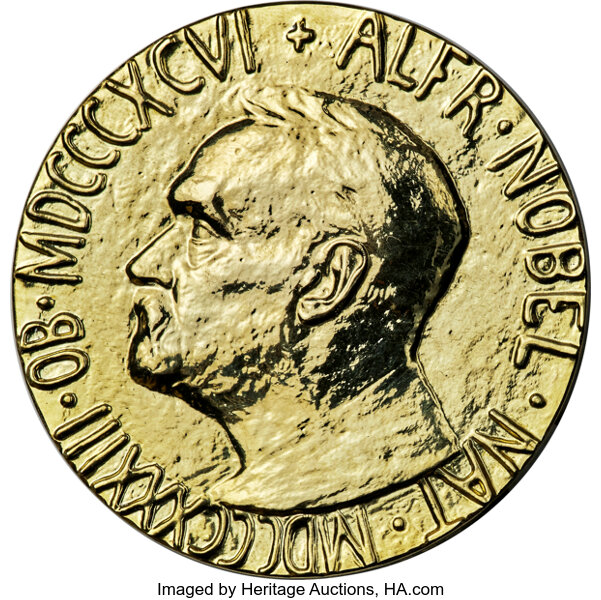 Russian journalist, Dmitri A. Muratov, decided he could help Ukrainian refugees by auctioning off his prized possession, the Nobel Peace Prize he won in 2021. Muratov was the editor-in-chief of the Russian newspaper Novaya Gazeta and a very vocal advocate for an independent press in Russia. In March of 2022, Muratov was attacked; someone tossed a ‘mixture of red paint and acetone’ at his face causing a chemical burn to his eyes. He was then forced to shut down the paper the same month in response to the Kremlin’s harsh press laws.
Russian journalist, Dmitri A. Muratov, decided he could help Ukrainian refugees by auctioning off his prized possession, the Nobel Peace Prize he won in 2021. Muratov was the editor-in-chief of the Russian newspaper Novaya Gazeta and a very vocal advocate for an independent press in Russia. In March of 2022, Muratov was attacked; someone tossed a ‘mixture of red paint and acetone’ at his face causing a chemical burn to his eyes. He was then forced to shut down the paper the same month in response to the Kremlin’s harsh press laws.
As we all know, the war in Ukraine has forced millions of people to flee their homes, and the need for assistance for these refugees is overwhelming. Muratov wanted to help the refugees and decided the best way would be to put his medal up for auction and donate the proceeds; he had already donated the $500K cash award to charity. His inspiration came from the Danish physicist Niels Bohr who was awarded the Nobel Peace Prize in 1922 and sold it at auction in 1940 to raise money for the Fund for Finnish Relief. (The fund helped refugees in Finland after the Soviet invasion in 1939.) The buyer of Bohr’s medal donated it to the Danish Historical Museum, which still has it on display today.
The auction began on June 1st and closed on June 20th at a live event in Manhattan. On the morning of June 20th, the online bidding was already up to $550K, and then an auctioneer took over to close the sale. Bidders worldwide were bidding in increments of $100K – $200K at a clip. The price quickly flew to $16.6M, but it would not end there. An anonymous phone bidder jumped the price from $16.6M to an astonishing $103.5M, causing the room to erupt in cheers and setting an auction record. Before this sale, the most expensive Nobel Prize sold at auction was set in 2014, when James Watson’s 1962 medal sold for $4.76M.
The proceeds were donated to UNICEF to help children displaced by the war. In addition, the auction house did not receive a buyer’s or seller’s premium – ALL THE MONEY WAS DONATED! Muratov hopes this sale will inspire more people to donate or auction some of their prized possessions to help those in need.
Holy Artwork, Batman!
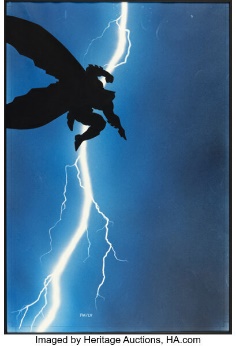 The original artwork for the comic book Batman: The Dark Knight Returns #1 just dashed across the auction block. Frank Miller wrote the four-issue series featuring Batman as the Dark Knight, published by DC comics in 1986. The comic books were illustrated by Miller along with Klaus Janson and Lynn Varley.
The original artwork for the comic book Batman: The Dark Knight Returns #1 just dashed across the auction block. Frank Miller wrote the four-issue series featuring Batman as the Dark Knight, published by DC comics in 1986. The comic books were illustrated by Miller along with Klaus Janson and Lynn Varley.
The story pulls Bruce Wayne out of retirement to battle crime when he was 55 years old. Batman faces opposition from the police force and the United States government as he encounters villains like Two-Face, the Joker, and even Superman, who he believes is a pawn of the government. This version of Batman introduces a more mature version of the character and is considered one of the most important Batman stories written.
Miller and Varley did the original artwork for the cover depicting Batman in silhouette with a lightning bolt erupting in the sky. The 12 x 18-inch artwork was created by Miller using ink over graphite on Bristol board, and then airbrushed with color by Varley. It was expected to bring more than $2M and just hit the mark as it sold for $2M ($2.4M w/p).
Larry Forman – The Secret Notebook
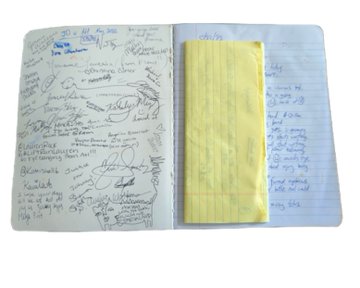 The Johnny Depp/Amber Heard court battle was certainly not a secret, but a notebook that an attorney kept during part of the trial was. Millions of people tuned in to watch the real-life courtroom drama of Johnny Depp suing his ex-wife Amber Heard over defamation charges, setting a record for Court TV viewership. During the trial, an attorney from Kentucky traveled to Fairfax County, Virginia, where the trial took place, to view the proceedings. The attorney, Larry Forman (aka ‘The DUI Guy’) sat in the courtroom for six days of the six-week trial and recorded his observations.
The Johnny Depp/Amber Heard court battle was certainly not a secret, but a notebook that an attorney kept during part of the trial was. Millions of people tuned in to watch the real-life courtroom drama of Johnny Depp suing his ex-wife Amber Heard over defamation charges, setting a record for Court TV viewership. During the trial, an attorney from Kentucky traveled to Fairfax County, Virginia, where the trial took place, to view the proceedings. The attorney, Larry Forman (aka ‘The DUI Guy’) sat in the courtroom for six days of the six-week trial and recorded his observations.
In case you are unfamiliar with the lawsuit, Depp sued Heard for $50M over an op-ed she wrote for the Washington Post in 2018, claiming she was a domestic violence victim. Heard countersued Depp for $100M, claiming that Depp defamed her through statements made by Depp’s divorce attorney, Adam Waldman. In the end, Depp prevailed, and the jury awarded him $10 million in compensatory damages and $5 million in punitive damages (the latter of which, the judge adjusted that down to $350K, as Virginia law limits punitive damages). Heard was awarded $2 million, as the jury believed that Depp’s attorney did make defamatory statements regarding her.
Over the six days Larry Forman watched from the gallery, he took 60 or so pages of notes, including information that was not aired on TV. Forman stated, “I recorded my personal impressions of the jurors’ reactions to the testimony, as well as things the lawyers were doing that was not captured on video.” When the trial ended on June 1, 2022, Forman put his notebook up for sale on eBay for just 99 cents – the cost of the notebook. After a week of bidding, the notebook racked up 142 bids and sold for $14,969! Forman donated 100% of the proceeds to the Children’s Hospital Los Angeles (CHLA) because of testimony he heard during the trial referring to an unfulfilled pledge made by Amber Heard. After her divorce in 2016, she pledged to donate half of her $7 million settlement to CHLA; to date, the hospital has only received $250K of the pledged amount. It’s been reported that Elon Musk made the $250K donation on her behalf.
Boba Fett Action Figure Achieves New Record
 If you’re a Star Wars fan, you probably know who Boba Fett is… but for those who aren’t familiar, Boba Fett is a fictional character from the Star Wars movies, books, video games, and television specials. He is a bounty hunter who served the crime lord Jabba the Hutt and tracked Han Solo through the galaxy. Over the years, Fett has developed quite a following, and Star Wars memorabilia collectors enthusiastically seek to find his character’s prototype action figures.
If you’re a Star Wars fan, you probably know who Boba Fett is… but for those who aren’t familiar, Boba Fett is a fictional character from the Star Wars movies, books, video games, and television specials. He is a bounty hunter who served the crime lord Jabba the Hutt and tracked Han Solo through the galaxy. Over the years, Fett has developed quite a following, and Star Wars memorabilia collectors enthusiastically seek to find his character’s prototype action figures.
The Kenner Toy Company developed the prototype action figure in 1979 for their Star Wars toy line. Unfortunately, Kenner pulled the figure from the line as they realized that the toy might be a choking hazard. Kenner made about 100 prototypes, and it is believed that only 24 or so still exist. Boba Fett figures are among the most expensive Star Wars collectibles sold at auction, and prices have escalated rapidly in recent years. This is likely due to Fett’s return to the screen as a character in the Star Wars streaming series The Mandalorian and The Book of Boba Fett.
At just 3 ¾ inches tall, the unpainted Boba Fett L-slot rocket-firing prototype was the star of a recent sale of Star Wars collectibles. Just three months after a record price of $204K was achieved for a Boba Fett J-slot figure, the L-slot figure shot passed it. According to the auctioneer, the L-slot figure was not any rarer than the J-slot, and the condition was a lower grade than previous prototypes, but it still managed to hit its mark. The figure was estimated to make $100 -200K, hitting the high estimate and establishing a new record price once the premium was added: $236K. In addition, the sale had a 100% sell-through rate!
In case you are wondering, the L-Slots have a slot on the back of the figure shaped like a backwards L, while J-Slots have a slot shaped like the letter J. The J-Slot was designed to help prevent accidents since it added an extra step before being released.
____________________
The Art Market
By: Nathan
Christie’s London 20th/21st Century Sale
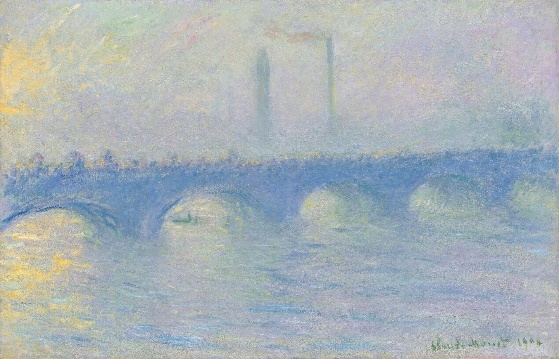 On Tuesday, June 28th, Christie’s London hosted their 20th/21st Century evening sale. Though most of the lots were post-war and contemporary artists like Damien Hirst, Jean-Michel Basquiat, and Henry Moore, the top lots of this sale, interestingly enough, were taken by impressionist pieces. Two paintings by Claude Monet each brought in £26M / $31.77M (or £30.1M / $36.73M w/p). The first, a blue and yellow-accented oil painting of London’s Waterloo Bridge, had been in the private collection of the American watchmaker Arde Bulova and his heirs since 1951. Back then, Bulova bought the Monet from the New York art dealer Knoedler & Co. for $4,000. While that would be around $45,000 today, it only shows how much the value of Monet’s works has skyrocketed over the last century. While not as drastic of a value increase, the other Monet, Nymphéas, temps gris, was part of the Onassis family collection which last sold in 2006 at Christie’s New York for $11.2M w/p.
On Tuesday, June 28th, Christie’s London hosted their 20th/21st Century evening sale. Though most of the lots were post-war and contemporary artists like Damien Hirst, Jean-Michel Basquiat, and Henry Moore, the top lots of this sale, interestingly enough, were taken by impressionist pieces. Two paintings by Claude Monet each brought in £26M / $31.77M (or £30.1M / $36.73M w/p). The first, a blue and yellow-accented oil painting of London’s Waterloo Bridge, had been in the private collection of the American watchmaker Arde Bulova and his heirs since 1951. Back then, Bulova bought the Monet from the New York art dealer Knoedler & Co. for $4,000. While that would be around $45,000 today, it only shows how much the value of Monet’s works has skyrocketed over the last century. While not as drastic of a value increase, the other Monet, Nymphéas, temps gris, was part of the Onassis family collection which last sold in 2006 at Christie’s New York for $11.2M w/p.
But while the impressionist pieces took the top spots, the more modern works also had their moments. Yves Klein’s 1960 work Anthropométrie de l’époque bleue, which was used as the thumbnail photo for the sale’s online material, reached nearly as much as the Monets. What brought people in, I believe, was not only Klein’s reputation or the size of the work (about five feet by ten feet) but the medium. Klein spread resin onto paper and then brushed the adhesive with dry pigment, or paint without any liquids added, so it’s still in its powdered state. While the work fell just a few hundred thousand pounds short of its original estimate, it still brought in £23.5M / $28.7M (or £27.2M / $33.23M w/p).
While it wasn’t one of the top lots, one of the more noteworthy pieces sold on Tuesday was Balloon Monkey (Magenta) by Jeff Koons. I wrote about the large stainless steel sculpture earlier this month: its now-previous owner, Victor Pinchuk, announced his intentions to give all proceeds towards medical supplies for those affected by the war in Ukraine. Though I predicted Pinchuk’s announcement would greatly increase interest in the work, the sculpture sold within its £6M to £10M estimate, with the hammer coming down at £8.6M / $10.5M (or £10.14M / $12.39M w/p). It’s still a substantial amount and will no doubt prove helpful in relieving the thousands of Ukrainians affected by the Russian invasion.
Christie’s London Marc Chagall Sales
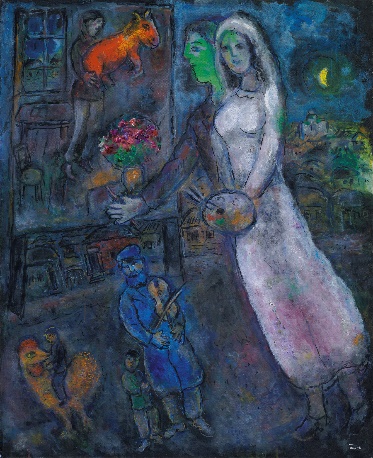 On Tuesday and Thursday, June 28th and 30th, Christie’s London held a duo of sales dedicated exclusively to the work of Marc Chagall. The Tuesday sale consisted of twenty paintings, while the Thursday auction was an online sale of seventy-five prints. All the featured works came from the artist’s estate, and both sales did exceptionally well. All but two of the twenty available lots in the first sale sold above the specialists’ estimates. The two top lots performed more or less the way the experts expected: the 1984 oil and tempera on canvas work Le peintre et les mariés aux trois couleurs sold for £1.3M / $1.59M (or £1.6M / $1.96M w/p), falling nicely within its original £1M to £2M estimate. Not long after, Le peintre, la mariée et son tableau ou Couple et violoniste sold for £1.1M / $1.34M (or £1.36M / $1.66M w/p), just a hair short of its £1.2M minimum estimate.
On Tuesday and Thursday, June 28th and 30th, Christie’s London held a duo of sales dedicated exclusively to the work of Marc Chagall. The Tuesday sale consisted of twenty paintings, while the Thursday auction was an online sale of seventy-five prints. All the featured works came from the artist’s estate, and both sales did exceptionally well. All but two of the twenty available lots in the first sale sold above the specialists’ estimates. The two top lots performed more or less the way the experts expected: the 1984 oil and tempera on canvas work Le peintre et les mariés aux trois couleurs sold for £1.3M / $1.59M (or £1.6M / $1.96M w/p), falling nicely within its original £1M to £2M estimate. Not long after, Le peintre, la mariée et son tableau ou Couple et violoniste sold for £1.1M / $1.34M (or £1.36M / $1.66M w/p), just a hair short of its £1.2M minimum estimate.
The third-place lot came as a bit of a surprise. The 1962 work entitled A Vava Chagall, citoyenne d’honneur des Collines à Vence is made from pastel, gouache, and India ink on vellum laid on panel. Though thought to go for around £80K to £120K, the work is quintessential Chagall. Chagall features like flowers, animals, and almost floating human figures all have their place in this relatively small piece, measuring only 18 by 23 inches. But the most notable feature is the brilliant pastel colors, showing influence from Fauvist art. Bidders launched the hammer price past the high estimate and finally peaked at more than three times what the specialists had expected. The hammer came down at £430K / $525K (or £541.8K / $661.6K w/p).
Though it was a nice surprise, it was by no means the biggest one that day. Chagall’s 1978 painting Les mariés guidés par le roi David was originally meant to sell for £60K maximum. It may not have the bright colors Chagall’s works often do, but it still is easily identifiable as being made by him: a crowned figure meant to represent King David points a group of figures toward a city. Among these figures is a violinist, a common image in Chagall’s work… so much so that Chagall’s paintings, like The Green Violinist and The Fiddler, served as one of the inspirations behind the 1964 musical Fiddler on the Roof. The violinist accompanies a Jewish married couple, identified as such by the red chuppah wedding canopy situated above the pair. So even though the painting is mainly grey with some gold accents, it has all the things you would want in a work by Marc Chagall. Some buyers saw the work’s potential since it sold for more than four times the maximum estimate at £260K / $318.1K (or £327.6K / $400.8K w/p).
In total, the Tuesday sale brought in £7.8M (or $9.5M), nearly £1.3M more than what Christie’s specialists were expecting. This certainly set some high expectations for the Thursday online sale. While both sales exceeded specialists’ expectations, the online sale did particularly well regarding how often the specialists accurately predicted each item’s hammer price. That is, except for the top lots. While specialists predicted nothing would go for more than £60K, Chagall’s lithograph Le magicien de Paris brought in two-and-a-half times its high estimate when the hammer came down at £150K / $154.5K (or £189K / $229.2K w/p). A few moments later, another L’Auge II lithograph sold for £55K / $66.7K (or £69.3K / $84K w/p), over three times the original £15K estimate.
In total, the online sale brought in £825K (or $1M), over £100K more than what was expected. But what was especially noteworthy was how Christie’s experts accurately predicted the hammer prices for forty-seven of the seventy-five available works or about sixty-three percent. Twenty-four lots sold above estimate, while only two works sold under estimate, and another two went unsold.
Sotheby’s New York Old Masters Two-Parter
On Wednesday and Thursday, May 25th and 26th, Sotheby’s New York location held its two-day Old Masters sale. Wednesday’s auction was the main slate, a live event with fifty-four available lots. This session featured all the high-value pieces, including many works from a number of prominent private collections. The next day’s sale was an entirely online event, made up of the lower-valued works of varying sizes, styles, and estimate ranges. While a small handful of lots did rather well, overall the two sales ended up being rather disappointing. Now, I don’t blame buyers for not diving right into this sale. The preceding week saw billions of dollars of art dumped onto the market at all the major auction houses. So it could have been a genuine lack of interest, or it could have just been fatigue that led buyers away from Sotheby’s.
Specialists at Sotheby’s did predict the top lot with some accuracy: The Return from the Inn by the Flemish master Pieter Brueghel the Younger. The snowy village scene features a wife, or perhaps a mother, pulling someone away from the bar fight happening in the background. The work was from the collection of the Tahitian philanthropist Paul Yeou Chichong, and Sotheby’s specialists valued the work at $2M to $3M. The hammer came down at $1.5M (or $1.87M w/p), which despite falling short of the estimate was a great leap in value from its last appearance at auction. The last time the Brueghel cross the block was at Sotheby’s in London in 1988 Old Masters sale, where it sold for £380K, or about $699.2K. Another one of the sale’s highlights was the second place lot. A still-life by the Dutch master Willem Claesz. Heda (also suspected of having created the still life discovered in that Australian museum storeroom) was predicted to go for anywhere between $500K and $700K. I was glad to see it sold for slightly above estimate at $750K (or $945K w/p) since it’s such a beautiful work, featuring the pewter and silver dishes, cracked nuts, and unfinished food typical of Heda’s vanitas works. Chichong was the seller of this work as well, having acquired it at a Sotheby’s Old Masters sale in 2010 for £300K, which was equivalent to $432.6K. So he made quite a nice profit on Wednesday. In third was a run-of-the-mill Madonna and child work by Simon Vouet, the court painter to the French king Louis XIII. It did rather well, hitting its low estimate at $400K (or $504K w/p).
Both sales brought in far less than predicted despite some of these lovely works. This was because over a third of the lots, or about nineteen of the fifty-four, went unsold during the live sale. More impactful, however, was the fact that many of the lots during the online sale had very low reserves or no reserves at all. They, therefore, sold for dramatically below their estimates. A Holy Family portrait by Giorgio Vasari, for example, sold for $110K when it was expected to bring in at least $300K. Later on in the online sale, a nineteenth-century Dutch interior scene that was expected to go for anywhere between $1.5K and $3K sold for a mere $800. Yes, it wasn’t in the best condition, with innumerable dots and patches of paint having flaked away from the panel. But regardless, it was incredible to see house specialists so off the mark. Fifty of the one hundred thirteen lots available in the online sale, or around 44%, sold below their estimates. An additional twenty-eight, or one-quarter of the total lots, went unsold. Across both sales, Sotheby’s specialists had an abysmal accuracy rate when it came to predicting the hammer prices. Out of the one hundred sixty-seven lots from both sales, only twenty-seven lots sold within their estimates. That’s only 16.7%. Sotheby’s predicted to bring in a minimum of $7M, so it was truly disappointing to see everything go for just $5.1M.
____________________
Deeper Thoughts
By: Nathan
Another Year for the Sagrada Familia
I first visited the Sagrada Família in Barcelona in January 2017. I only knew what the structure looked like from the laminated posters plastered onto the walls of classrooms where I had my Spanish lessons in high school. The series of towers clustered around the nave made it seem like half pipe organ, half abandoned factory. It was strange, unlike any church I had ever seen up close. I entered on the northeast side, underneath a façade that looked like it was painstakingly sculpted out of a single piece of sandstone. Shepherds and angels and birds and trees rose above my head, protruding from the rock in a way that reminded me of drip castles you make on the beach when you’re a child. Having grown up around New York, I had seen many impressive buildings, and this one was incredibly striking. Of course, not everyone has been as kind as I was. George Orwell, who coincidentally shares a birthday with the church’s architect Antoni Gaudí, was far more brutal in his commentary. In his Homage to Catalonia, Orwell referred to the Sagrada Família as “one of the most hideous buildings in the world.” He further wrote that the anarchist troops he accompanied “showed bad taste in not blowing it up.”
 While the exterior was spectacular, it was not the most impressive feature during my visit to the site. It wasn’t until I passed through the doors beneath the nativity sculptures and entered the structure that I saw its true beauty. Along the nave, a series of columns extended upward. They were fluted as you would see on a classical Doric column from the Parthenon. But they became very different the further upward you looked. They were topped with these large bulbs, which continued and branched off; like stone stems in a massive bouquet, supporting an enormous canopy of flower petals. The columns just went up and up; sort of melting into the ceiling.
While the exterior was spectacular, it was not the most impressive feature during my visit to the site. It wasn’t until I passed through the doors beneath the nativity sculptures and entered the structure that I saw its true beauty. Along the nave, a series of columns extended upward. They were fluted as you would see on a classical Doric column from the Parthenon. But they became very different the further upward you looked. They were topped with these large bulbs, which continued and branched off; like stone stems in a massive bouquet, supporting an enormous canopy of flower petals. The columns just went up and up; sort of melting into the ceiling.
It was already incredible, but it was a little overcast that day. I had only been inside for a few minutes before finally, the sun came out. As soon as that happened, the space became flooded with green, red, yellow, and orange light streaming in through the tall windows along the side aisles. Once the colored light filled the church, the structure transformed from one of stone to something made of actual flowers. It was awesome. Quite literally, being very easy to fill one with true awe. I just wanted to stand in the middle of that nave for the rest of the day, hoping the sun would never set.
Saturday, June 25th, marks Antoni Gaudí’s one hundred seventieth birthday, in the one hundred fortieth year of the Sagrada Família’s construction. The construction board has been predicting that the structure will finally be completed by 2026, in time for the one-hundredth anniversary of Gaudí’s death. Even without Covid-related delays, completion by 2026 is a tall order. Despite the likelihood that 2026 the Sagrada Família will probably lack all eighteen planned spires and steeples. I would like to revisit and see the Sagrada Família within my lifetime. I’m still (relatively) young, so it’s not unreasonable. Though still unfinished, standing in the Sagrada Família’s nave is as close to a spiritual experience that even an irreligious person can have. So here’s to Antoni Gaudí. It’s very fitting that such a beautiful edifice can serve as a testament to the beautiful mind of one of Catalonia’s artistic legends.
What’s Up with Peter Max’s Family?
 Peter Max has always been one of those names I’ve been familiar with but hadn’t always fully comprehended its importance. My parents had a framed Peter Max poster hanging up in the house, so I saw one of his American flag paintings every time I walked out the door. But it was only more recently that I started to read about his life and works, from being a counterculture pop art figure to doing Taylor Swift’s portrait. But I paid particular attention to his most recent years, which have been unfortunate.
Peter Max has always been one of those names I’ve been familiar with but hadn’t always fully comprehended its importance. My parents had a framed Peter Max poster hanging up in the house, so I saw one of his American flag paintings every time I walked out the door. But it was only more recently that I started to read about his life and works, from being a counterculture pop art figure to doing Taylor Swift’s portrait. But I paid particular attention to his most recent years, which have been unfortunate.
Peter Max is now 84-years-old and has suffered from dementia caused by Alzheimer’s disease for about ten years. His daughter Libra is currently in a legal battle regarding her father’s guardianship by the attorney Barbara Lissner. Most people in the United States have probably heard about such legal arrangements mainly thanks to attention gathered by pop star Britney Spears. Her successful attempt to free herself from a 13-year conservatorship held by her father drew attention to the need for reform in conservatorship law. But while a conservatorship gives a conservator control over a person’s finances, guardianship grants much more control over a ward’s day-to-day affairs. In the lawsuit, Libra Max accuses Lissner of intentionally isolating the artist from friends, withholding medical information from his family, charging excessive fees, and siphoning money from the artist’s estate.
However, this case may not be as clear-cut as the Britney Spears conservatorship controversy. This seems less like a concerned daughter seeking to free her father from an abusive guardianship and more like some entitled children fighting to get the better portion of their famous father’s estate. Both Libra and her brother Adam each control 40% of Peter Max’s estate, and each sibling has pulled their fair share of tricks to increase their fortunes. In 2019, Adam Max accused Libra of attempting a hostile takeover of their father’s estate. That same year, however, Adam was accused of abusing his father’s disability to mass-produce Peter Max-style works. An expose in the New York Times described Adam hiring street artists to “[churn] out art in the Max aesthetic: cheery, polychrome, wide-brushstroke kaleidoscopes on canvas. Mr. Max would be instructed to hold out his hand, and for hours, he would sign the art as if it were his own, grasping a brush and scrawling Max.”
Of course, Peter Max likely knew of his children’s behavior, hence why he actively sought a third party as a legal guardian. In 2015, Peter Max objected to having his daughter gain control over his life and assets, consenting to the court appointing a guardian on his behalf.
Selling A Koons for Ukraine

A large Jeff Koons sculpture will be coming across the auction block at the end of the month. The work, Balloon Monkey (Magenta), is owned by the Ukrainian billionaire Victor Pinchuk, who purchased the work from Larry Gagosian not long after its creation in 2013. Christie’s specialists estimate that the sculpture will likely sell for £10 million (or about $12 million). According to Pinchuk, the proceeds from the sale will go towards purchasing medical supplies for Ukrainians affected by the ongoing war. This is very fitting with Pinchuk’s past actions. He and his wife Olena, daughter of former Ukrainian president Leonid Kuchma, have generously donated to several charitable causes through the Victor Pinchuk Foundation, the largest private philanthropic organization in Ukraine. In fact, since the outbreak of the war in late February, the Pinchuks have already given away an estimated $30 million towards relief efforts.
However, Christie’s specialists may be lowballing the estimate a little since many other large Koons works have reached much higher amounts than the mere £10 million. Most recently, Balloon Monkey (Orange), from the same series as the work up for sale, sold at Christie’s New York in 2014 for $23 million (or $25.9 million w/p). The year before, Balloon Dog (Orange) sold for $52 million (or $58.4 million w/p). Also, with the explicitly stated objective of raising money for humanitarian purposes, the hammer price is bound to be far higher than the specialists’ estimate. When asked to comment on the Pinchuks’ decision, Koons stated, “Art’s true value is to be of service to humanity, and there could not be a higher calling at this moment than to support the Ukrainian people.” The Koons work will be part of the Christie’s 20th/21st Century sale that will take place at their London saleroom on June 28th. Though it will not be the highest-valued work in the sale (with two Monet works set to bring in far more), the circumstances of its appearing at auction may cause it to be the star of the sale.
A Bad Week for Basquiat
Police in New York are still on the lookout for a couple who just decided to walk out of a gallery with a Basquiat. On May 14th, a man and a woman walked into Taglialatella Galleries in Manhattan’s Chelsea neighborhood. While their identities are not yet determined, one witness stated that they spoke with an “unknown European accent”. Security video footage shows the couple wandering around the gallery until, at around 5:30 pm, they stumbled upon the office. There, they found a framed print by Jean-Michel Basquiat entitled Dog Leg Study, created in 1983 and on sale for $45,000. They also found a bottle of Maker’s Mark on the shelf.
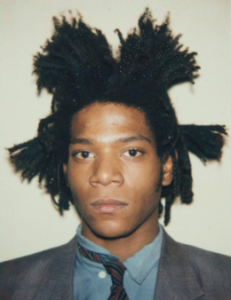 While confidence is often very disarming, the gallery attendants knew that you don’t just walk out with a framed work under your arm. According to gallery owner Brian Swarts, the attendant “literally pulled the piece from the guy’s hand.” Previous encounters likely prepared the staff for this situation since the same gallery had a similar incident last year. Someone tried to walk out with a small Kaws figurine on display. Though they saved the work from being stolen, the couple made off with the bottle of bourbon, which was only a third full, it seems.
While confidence is often very disarming, the gallery attendants knew that you don’t just walk out with a framed work under your arm. According to gallery owner Brian Swarts, the attendant “literally pulled the piece from the guy’s hand.” Previous encounters likely prepared the staff for this situation since the same gallery had a similar incident last year. Someone tried to walk out with a small Kaws figurine on display. Though they saved the work from being stolen, the couple made off with the bottle of bourbon, which was only a third full, it seems.
This was the first of several incidents where Basquiat works, or alleged works, were involved over the past few weeks. Of course, there were the revelations surrounding dealings at the Galerie Danieli in Palm Beach, where a €495 Basquiat reproduction was on sale as a genuine for $12 million. But it seems the FBI was very busy in Florida lately, not just in Palm Beach. The FBI also sent agents to Orlando to investigate claims that the Orlando Museum of Art (OMA) owns twenty-five works by Basquiat that may be forgeries. According to the alleged provenance, Basquiat sold these works to a screenwriter named Thad Mumford, who lost them in 2012 when the contents of his Los Angeles storage unit were auctioned off.
Experts are divided over the works’ authenticity. Aaron De Groft, OMA’s director, has asserted their authenticity. James Blanco, a handwriting expert, verified the signatures, while professor Jordana Moore Sagesse also attributes the works to Basquiat in her book Reading Basquiat. Most importantly, curator Diego Cortez, who served on the Basquiat estate’s authentication committee, also verified the works. So if they’re fakes, they’re definitely good fakes. Larry Gagosian, Basquiat’s patron, contests the works’ authenticity due to his unfamiliarity with them. Gagosian would probably be a good judge of authenticity since Basquiat’s studio sat on the ground floor below Gagosian’s home in Venice, California. The artist completing twenty-five works on canvas and cardboard completely behind his back is a little unlikely. After Gagosian’s objections, journalists looked further into the works’ allegedly dubious origins. One of the more compelling pieces of evidence against their authenticity is a brand specialist’s opinion regarding one of the works. Untitled (Self-Portrait or Crown Face II) was created on cardboard from a FedEx box, which is not particularly unusual for a work by Basquait. However, the text printed on the original box on the painting’s reverse, as the specialist pointed out, uses a font that FedEx would not use until 1994, six years after Jean-Michel Basquiat’s death.
The Rehs Family
© Rehs Galleries, Inc., New York – July 2022

